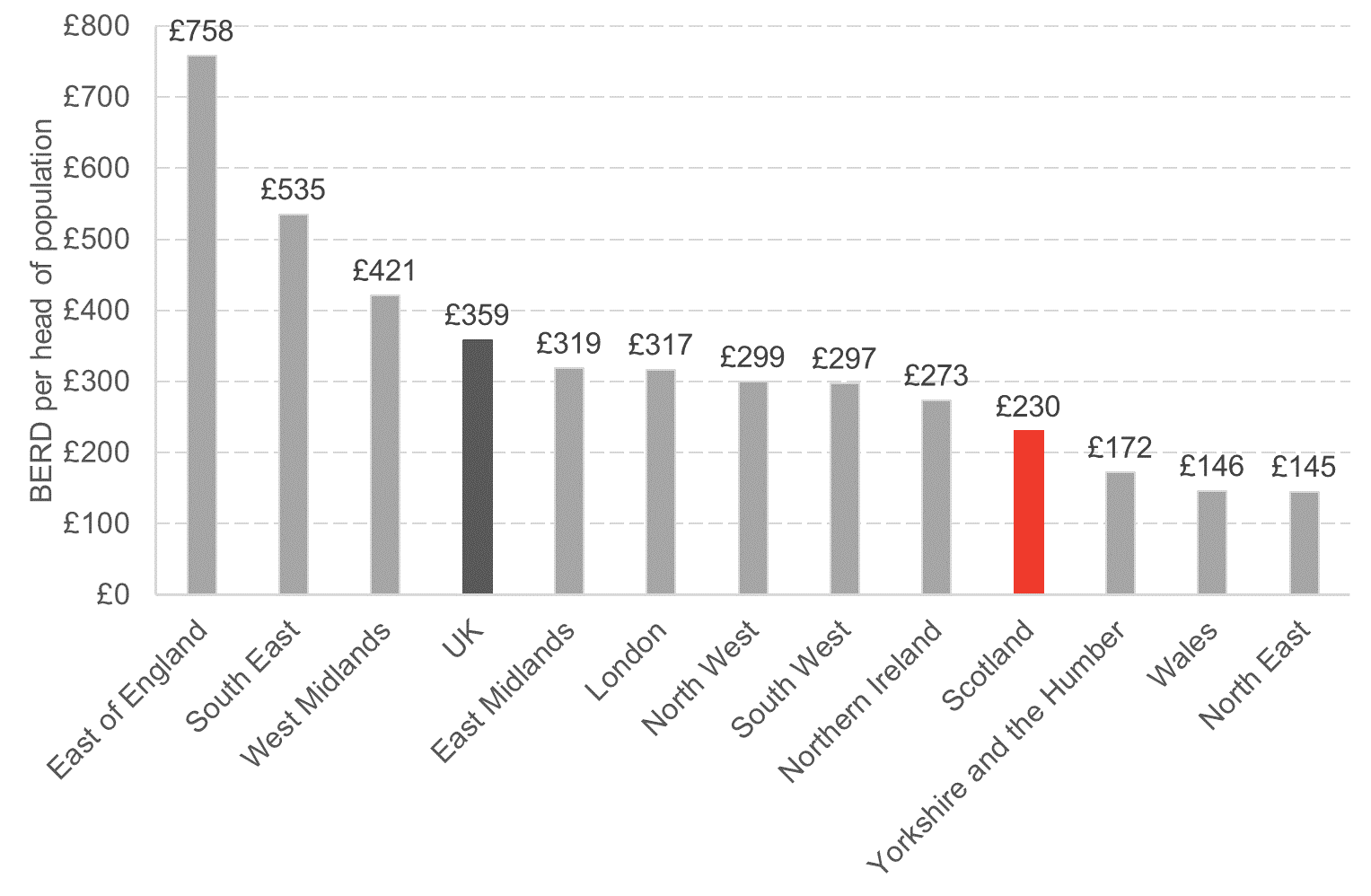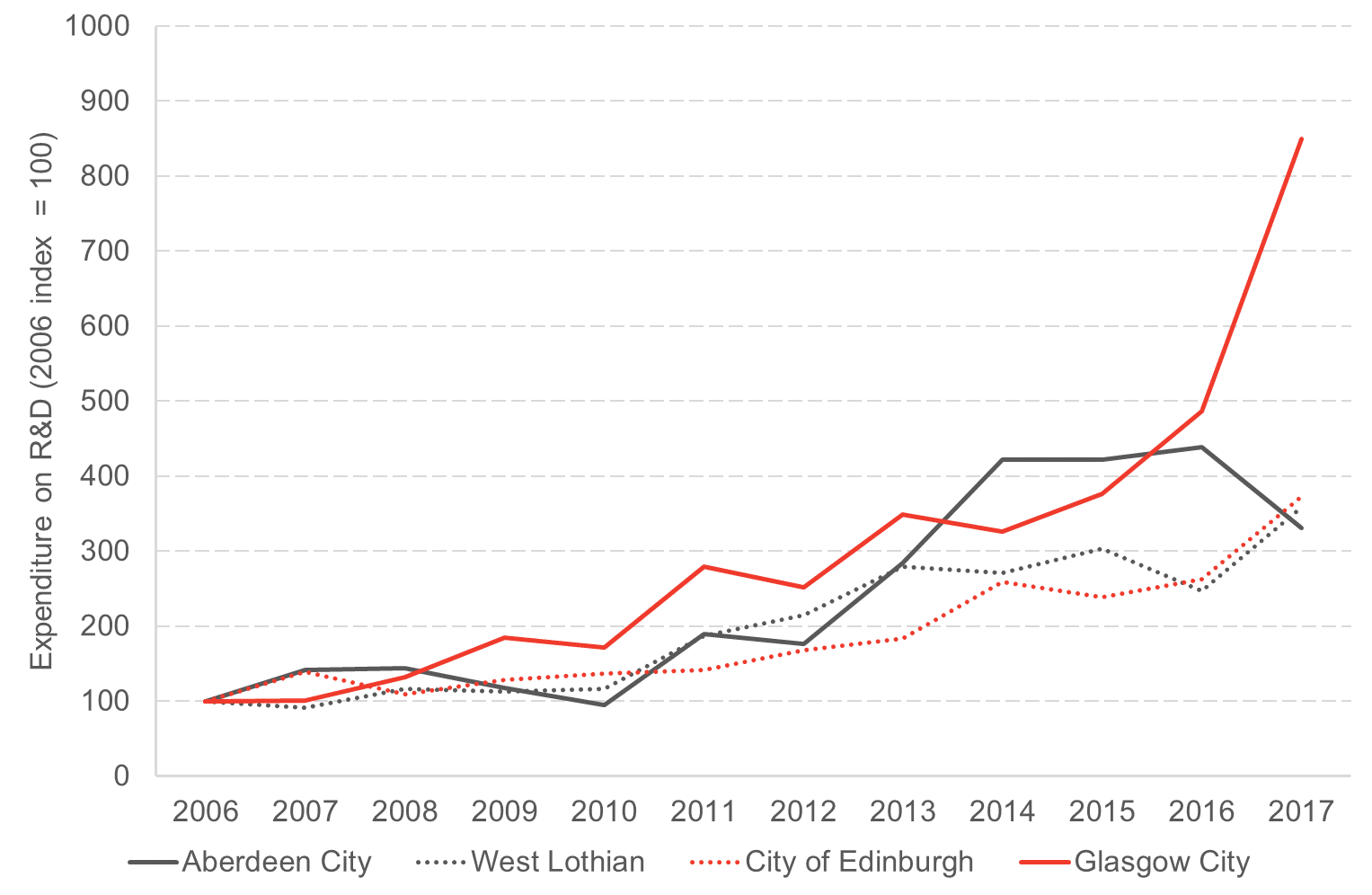Recently, the Scottish Government published their latest Business Enterprise Research and Development (BERD) results. This includes data on R&D activity of businesses operating in Scotland in 2017.
This led to the Scottish Government concluding that “Scottish businesses are investing record amounts in research and development” – with expenditure in Scotland now at its highest level since 2001.
This blog briefly summarises the key results.
Overview
Growing research and development activity in Scotland is a key objective of policymakers.
The latest data shows that in 2017, Scotland’s R&D expenditure growth outpaced UK growth.
R&D expenditure in Scotland was around £1.25bn in 2017 and associated with the employment of approximately 13,000 staff.
Between 2016 and 2017, Scotland’s expenditure on R&D increased in real terms by almost 14%, outpacing the UK growth of 3%. But as chart 1 highlights, Scotland’s R&D expenditure per head remains just over 60% of that of the UK.
Chart 1: Expenditure on R&D performed in businesses by Government Office Region: per head of population (2017)

Source: ONS and Scottish Government
Chart 2 highlights that the Scottish services sector has experienced the largest surge in R&D, with expenditure increasing by 755% since 2001.
So has Scotland turned a corner? We’d urge caution in jumping to such a conclusion just yet.
The largest share of R&D expenditure in 2017 came from the “miscellaneous business activities” group within the services industry. This group includes R&D activities such as information services, financial and insurance services, and other service activities. This division has increased 146% in real terms between 2016 and 2017 alone, and drives the large services increase in this year.
From the data release, it’s not entirely clear what the substance is that is driving the increase in this sector or indeed what R&D activities are actually taking place. A look at the time series suggests that R&D activity in this sector can be particularly volatile – increasing sharply one year, before remaining relatively flat the year after.
Chart 2: Expenditure on R&D performed within businesses in Scotland in real terms: 2017 prices (2001–2017)

Source: ONS and Scottish Government
At the same time, R&D activity in Scotland remains heavily concentrated. Almost 40% of total R&D expenditure came from just five companies and 50% from 10. This is much more concentrated than the UK as a whole.
Similarly, 71% of 2017’s R&D expenditure in Scotland took place in just four local authorities – West Lothian, Edinburgh, Aberdeen and Glasgow. That is, £880m out of Scotland’s £1.25bn spent. Additionally, 58% of employment associated with R&D in 2017 came from these areas too.
The growth of business R&D in Scotland is almost confined to these local authorities. In many areas, such as Dundee City, R&D expenditure has fallen.
This suggests that the goal of broadening out R&D activity across the Scottish economy still has some way to go.
Chart 3: Index of expenditure on R&D performed within businesses in Scottish local authorities (2006-2017)

Source: ONS and Scottish Government
Between 2016 and 2017, Glasgow’s expenditure increased from £115m to £200m, £107m of which came from services. Glasgow’s services sector increased R&D expenditure by 108% between 2016 and 2017.
Conclusion
These latest statistics on R&D activity undoubtedly contain positive news. The growth in R&D in particular in 2017 is welcome. However, as ever with headline statistics, it is important to dig underneath them to understand what they are telling us about the Scottish economy.
It remains a concern that Scottish R&D activity remains driven by a limited number of enterprises and in a limited number of areas of the country. Given the policy debate on growth that benefits all and all areas of the country or “inclusive growth”, this suggests that significant work needs to be done to achieve a more balanced economy.
Authors
Adam is an Economist Fellow at the FAI who works closely with FAI partners and specialises in business analysis. Adam's research typically involves an assessment of business strategies and policies on economic, societal and environmental impacts. Adam also leads the FAI's quarterly Scottish Business Monitor.
Find out more about Adam.
